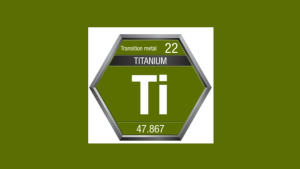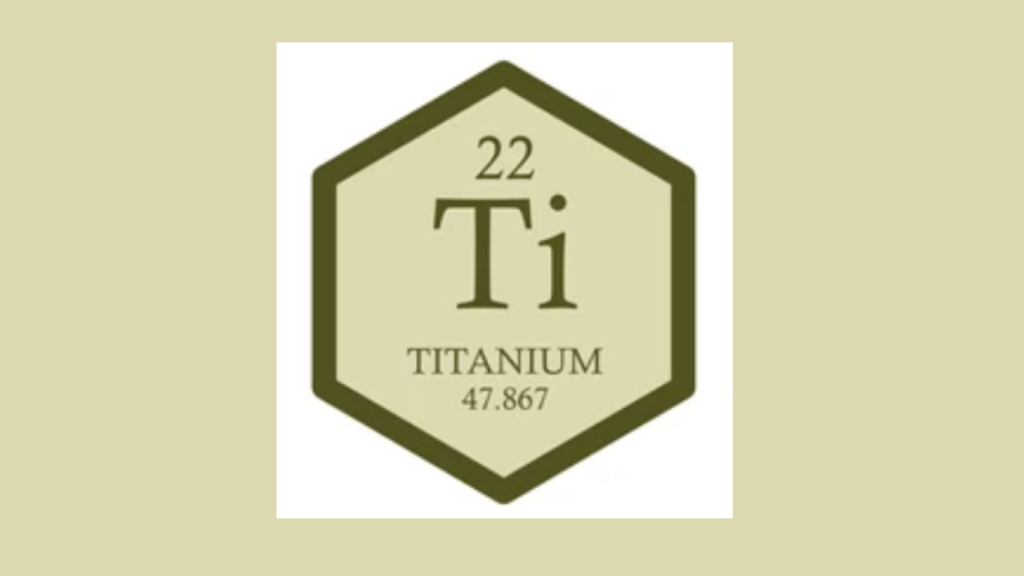The Titanium Electron Configuration can be expressed as 1s^2 2s^2 2p^6 3s^2 3p^6 4s^2 3d^2. Titanium is an element with the symbol Ti and atomic number 22.
Titanium belongs to the transition metals group and is known for its strong and lightweight properties. Due to its high strength-to-weight ratio and corrosion resistance, it is widely used in various industries, including aerospace, medicine, and sports. We will explore the electron configuration of titanium in more detail and understand its significance in this element’s chemical properties.
Properties Of Titanium
Titanium is a versatile and valuable metal known for its exceptional properties. It is widely used in various industries due to its excellent strength, corrosion resistance, and low density. Understanding the properties of titanium is essential for comprehending its applications and significance. In this article, we will explore the physical, chemical, and mechanical properties of titanium, shedding light on its unique characteristics.
Physical Properties
- Density: Titanium has a low density, making it lightweight and ideal for applications requiring strong yet light materials.
- Melting Point: Titanium’s melting point is approximately 1,668°C, which allows it to maintain its structural integrity at high temperatures.
- Color and Luster: This metal is distinct silver in color and exhibits a high level of luster, which contributes to its visual appeal.
Chemical Properties
Titanium boasts remarkable chemical properties that make it highly desirable in various environments.
| Chemical Property | Description |
|---|---|
| Corrosion Resistance | Titanium is highly resistant to corrosion, especially in marine and chemical environments, ensuring longevity in harsh conditions. |
| Reactivity | It exhibits low reactivity, forming a protective oxide layer that enhances its durability and stability in different chemical reactions. |
Mechanical Properties
- Strength: Titanium is renowned for its exceptional strength-to-weight ratio, offering superior strength compared to other metals.
- Ductility: Despite its strength, titanium is also ductile, allowing various shapes and structures to form without sacrificing its integrity.
The Electron Configuration Of Titanium
Titanium is a chemical element with the symbol Ti and atomic number 22. In this section, we will explore the electron configuration of titanium, which refers to the arrangement of electrons within its atomic structure. Understanding this arrangement is crucial as it significantly determines the element’s chemical properties and behavior.
Atomic Number
The atomic number of an element indicates the number of protons within its nucleus, which in turn determines its identity. Titanium, with an atomic number of 22, possesses 22 protons. This number defines titanium as a transition metal and places it on the periodic table in Group 4 and Period 4.
Orbital Diagram
An element’s orbital diagram visualizes its electrons’ arrangement in different energy levels or orbitals. Titanium has a total of 22 electrons, and according to the Aufbau principle, they occupy the lowest available energy levels first.
In titanium’s case, the first two electrons fill the 1s orbital, the next two electrons fill the 2s orbital, and the following six electrons are distributed across the three 2p orbitals. This gives us a total of ten electrons in the first three energy levels (1s, 2s, and 2p).
After the 2p orbitals are filled, the remaining twelve electrons occupy the 3s, 3p, and 3d orbitals. Specifically, the 3s orbital can hold a maximum of two electrons, the 3p orbitals can accommodate six electrons, and the 3d orbitals can contain ten electrons. In the case of titanium, the 3s orbital contains two electrons, the 3p orbitals contain six electrons, and the 3d orbitals have four electrons. Therefore, the electron configuration of titanium is [Ar] 3d2 4s2.
Electron Count
To summarize the titanium’s electron count, it has 22 electrons. This comprises two electrons in the 1s orbital, two in the 2s orbital, six in the 2p orbitals, two in the 3s orbital, six in the 3p orbitals, and four in the 3d orbitals.
The electron configuration of titanium, [Ar] 3d2 4s2, reflects this arrangement and provides valuable information about how titanium interacts with other elements in chemical reactions.
Understanding Electron Configuration
The electron configuration of an element is a vital concept in chemistry that helps us understand how electrons are organized within an atom. The arrangement of electrons in specific energy levels and orbitals determines the chemical properties and behavior of an element. In this section, we will explore the definition and importance of electron configuration, focusing specifically on titanium.
Definition
Electron configuration refers to the distribution of electrons into different energy levels and orbitals around an atom’s nucleus. Electrons occupy shells, which are grouped into energy levels or principal quantum numbers. Each shell has subshells, which further contain orbitals where electrons can be found. The electron configuration maps an element’s electron distribution, offering insights into its chemical reactivity and bonding tendencies.
Importance
Understanding electron configuration is crucial because it allows us to predict an element’s chemical behavior. By knowing how electrons are arranged, we can determine an element’s valence electrons—a key factor in chemical bonding. The electron configuration also helps explain the periodic trends observed across the periodic table, such as ionization energy, atomic radius, and chemical reactivity.
For titanium (Z=22), the electron configuration can be written as:
| Energy Level | Subshells | Electron Distribution |
|---|---|---|
| 1s | 2 | |
| 2s | 2 | |
| 2p | 6 | |
| 3s | 2 | |
| 3p | 6 | |
| 3d | 2 | |
| 4s | 2 |
From the electron configuration, we can determine that titanium has a total of 22 electrons. It has a filled 3d subshell (10 electrons) and two valence electrons in the 4s orbital. This configuration helps explain titanium’s properties, such as its ability to form +2 and +4 oxidation states and its preference for forming compounds with oxygen and other nonmetals.
Influence On Chemical Behavior
Titanium’s electron configuration greatly influences its chemical behavior. This is evident in its valence electrons and reactivity.
Valence Electrons
The valence electrons of titanium are located in the 3d and 4s orbitals. Titanium has 4 valence electrons, allowing it to form various chemical bonds.
Reactivity
Titanium exhibits low reactivity due to the presence of its stable valence electrons. This stability allows it to resist corrosion and oxidation, making it an ideal material for various applications.
Transition Metal Electron Configurations
Titanium’s electron configuration can be represented as [Ar] 3d2 4s2. Due to its properties, it belongs to the transition metal group and plays a crucial role in various industrial applications. These electron configurations determine its chemical behavior and reactivity in different environments.
Explanation
Transition metal electron configurations refer to the arrangement of electrons within the transition metal elements of the periodic table. These elements typically occupy the d-block and have partially filled d orbitals. Understanding their electron configurations is crucial for comprehending their chemical properties and reactivity.
Trends
In transition metal electron configurations, there are several notable trends:
- Stability: Transition metals tend to exhibit stable electron configurations by either completely filling their d orbitals or half-filling them. This stability can vary depending on the element and its position in the periodic table.
- Transition from s to d orbitals: As you move from left to right across the periodic table, there is a gradual transition from filling the s orbitals to the d orbitals. This is observed in the electron configurations of transition metals, where the d orbitals become increasingly populated.
- Exceptions: While many transition metals follow the predictable pattern of electron configuration, there are a few exceptions. For example, elements like chromium (Cr) and copper (Cu) deviate from the expected configurations due to the added stability of half-filled or completely filled d orbitals.
- Outermost electron configuration: Transition metals often possess a constant outermost electron configuration, with the number of electrons varying in the d orbitals.
- Transition in oxidation states: The electron configurations of transition metals contribute to their ability to exhibit multiple oxidation states. This ability enables them to form various complex compounds.
Understanding these trends in transition metal electron configurations allows chemists to predict and explain the behavior and properties of these remarkable elements. It aids in exploring their diverse applications across industries such as catalysis, materials science, and medicine.

Applications Of Titanium
Titanium is a versatile metal that has found numerous applications in various industries. Its remarkable strength, lightweight, corrosion resistance, and biocompatibility make it an ideal choice for various uses. In this article, we will explore three of the major applications of titanium: the aerospace industry, medical implants, and sports equipment.
Aerospace Industry
Titanium’s exceptional properties make it highly valued in the aerospace industry. Due to its strength-to-weight ratio, it is used extensively in the manufacturing of aircraft components, which allows for the construction of lightweight yet durable parts. Titanium alloys are commonly used in aircraft frames, engine components, landing gears, and fasteners. Metal corrosion resistance is particularly advantageous in the aerospace industry since it helps maintain the integrity and longevity of aircraft in harsh environments.
Medical Implants
Titanium’s biocompatibility, strength, and corrosion resistance make it a preferred material for medical implants. It is widely used in orthopedic implants such as joint replacements, bone plates, and screws. The human body readily accepts titanium, reducing the risk of rejection and promoting faster healing. The metal’s light weight is an additional benefit, as it helps reduce the strain on the patient’s body. Titanium implants are known for their long-term durability and reliability, making them a popular choice in the medical field.
Sports Equipment
Titanium’s exceptional strength and light weight also make it an ideal material for sports equipment. It is commonly used to produce bicycles, golf clubs, tennis rackets, and even diving equipment. Using titanium in these applications enhances performance due to its excellent vibration-damping properties, which can improve accuracy, power, and control. Additionally, its corrosion resistance ensures the longevity and durability of the equipment, even when exposed to challenging environments. Google maps
Frequently Asked Questions On Titanium Electron Configuration
How Do You Write The Electron Configuration For Titanium?
The electron configuration for titanium is 1s^22s^22p^63s^23p^64s^23d^2.
What Element Is 1s2 2s2 2p6 3s2 3p6 4s2?
Calcium is the element with the electron configuration 1s2 2s2 2p6 3s2 3p6 4s2.
What Is The General Configuration Of Ti?
The general configuration of TI involves setting up CPUs, memory, and peripherals for a specific application. It also includes selecting and programming the software to run on the hardware.
What Is The Condensed Electron Configuration Of Titanium Element 22?
The condensed electron configuration of titanium (element 22) is [Ar] 3d^2 4s^2.
Conclusion
Understanding titanium’s electron configuration is crucial for its properties and applications. By examining its arrangement, we gain insight into its behavior and reactivity. Titanium’s electron configuration, 1s22s22p63s23p63d24s2, reveals its stability and ability to form bonds. This knowledge deepens our comprehension of the element and its role in various industries.
